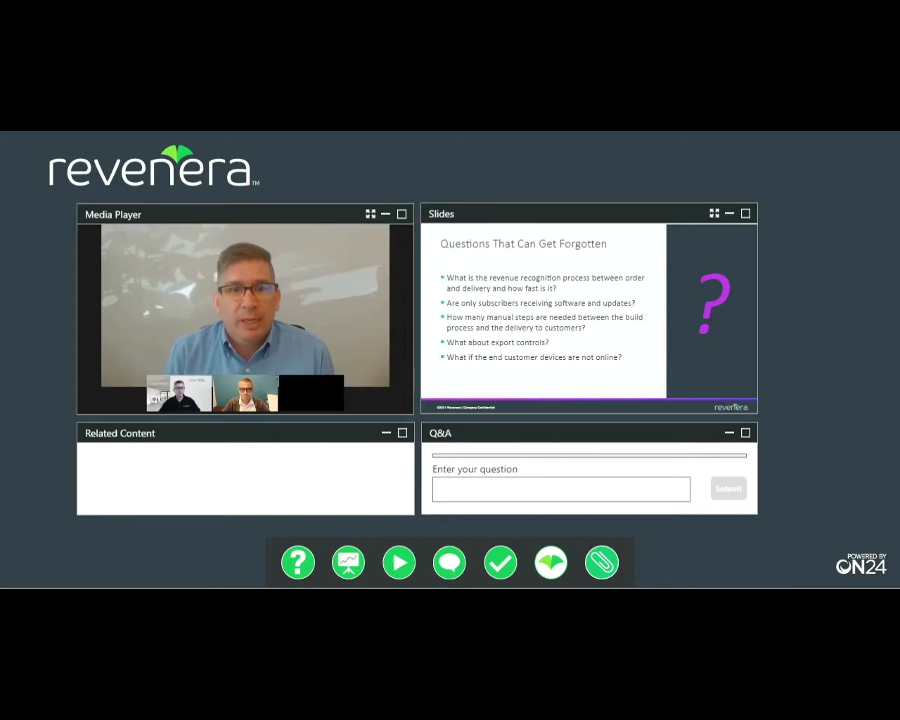Webinar
Growing Cloud-Native Application Revenue with Enhanced Entitlement Management
Discover how software providers boost revenue by aligning cloud-native delivery with entitlement management.
Original Air Date: September 27, 2021
Overview
If you're a software producer navigating the shift to cloud-native delivery, this webinar is a must-watch. Join Michael Goff, Principal Product Marketing at Revenera, as he hosts a dynamic conversation with Paul Nashawati, Senior Analyst at ESG, and Scott Nieman, Director of Product Management at Revenera.
Together, they unpack the explosive growth of containerized applications and the critical role entitlement management plays in monetizing and securing software in modern deployment environments. You'll gain insights into real-world use cases—from healthcare to enterprise software—and learn how leading organizations are streamlining delivery, reducing friction, and protecting revenue.
Whether you're delivering software to air-gapped environments or managing complex licensing across devices, this session will help you anticipate challenges and design smarter, scalable systems. Discover how to bridge the gap between CI/CD pipelines and entitlement controls, and why planning ahead can make or break your cloud-native strategy. Don’t miss this opportunity to learn from experts who are shaping the future of software monetization and delivery.
Recap
Key Themes and Takeaways
The Rise of Cloud-Native and Containerized Applications
Cloud-native microservices and containerized deployments are experiencing explosive growth, driven by digital transformation initiatives. Paul Nashawati shared ESG research showing that 77% of organizations already use containers in production, with another 21% planning to adopt them within 12 months. This shift is redefining how software is delivered, deployed, and monetized.
Bridging the Gap Between CI/CD and Entitlement Management
As software producers embrace continuous delivery, many overlook the importance of entitlement management. Scott Nieman emphasized that without proper entitlement controls, organizations risk delivering software to unauthorized users, missing upsell opportunities, and failing to recognize revenue. The webinar explored how integrating entitlement systems into CI/CD pipelines ensures secure, monetized delivery.
Real-World Use Cases: Healthcare and Enterprise Software
Two compelling examples illustrated the value of entitlement-aware container delivery. In healthcare, device manufacturers use local registries synced with entitlement systems to deliver updates securely and accurately to machines with specific configurations. In enterprise software, entitlement integration helped streamline delivery, support trial conversions, and enforce export controls—all while improving customer experience.
Common Pitfalls in Cloud Migration
Organizations often underestimate the complexity of refactoring applications for the cloud. Paul Nashawati noted that unforeseen costs and lack of entitlement planning can lead to repatriation back to on-premises environments. The webinar highlighted the importance of anticipating licensing, monetization, and compliance challenges early in the migration process.
Build vs. Buy: Entitlement Management Decisions
One of the most debated topics was whether to build or buy entitlement management functionality. While building offers customization, it also demands 24/7 support, deep expertise, and ongoing maintenance. The speakers advised weighing the long-term operational burden against the strategic value of outsourcing entitlement infrastructure.
Export Controls and Compliance in Cloud Delivery
Export control regulations remain critical in cloud-native environments. Scott Nieman explained how entitlement systems help prevent software from reaching denied parties or restricted geographies. This compliance layer is essential for global software producers managing sensitive or regulated products.
Enhancing Customer Experience Through Entitlement-Aware Delivery
Frictionless delivery was a recurring theme. By aligning entitlement data with deployment systems, software producers can ensure customers receive only the software they’re entitled to—reducing confusion, improving satisfaction, and enabling upsell opportunities. This approach also supports automated updates and secure delivery in air-gapped environments.
Speakers

Paul Nashawaty
Senior Analyst
ESG

Michael Goff
Principal Product Marketer
Revenera
Frequently Asked Questions
Entitlement management ensures that only authorized users receive access to specific software features, updates, or packages. It plays a critical role in monetizing software by enforcing licensing terms and preventing unauthorized use. In cloud-native environments, it helps software producers maintain control over containerized deployments and streamline customer experiences. Without it, companies risk revenue leakage and compliance issues.
Cloud-native applications are often deployed in dynamic environments where traditional licensing models don’t apply. Entitlement management helps software producers validate user access, enforce usage rights, and deliver updates securely. It also supports automated deployment workflows and ensures that customers only receive what they’ve paid for. This is essential for maintaining revenue integrity and reducing operational friction.
Integrating entitlement management into CI/CD pipelines allows software producers to automate secure delivery of containerized applications. It ensures that only entitled users or devices can pull images or receive updates during deployment. This integration helps prevent overuse, supports compliance, and enables real-time revenue recognition. It also improves the customer experience by aligning delivery with licensing terms.
Software producers often face unexpected costs, licensing complexities, and compliance risks when refactoring applications for cloud environments. Without proper entitlement planning, they may deliver software to unauthorized users or fail to monetize new features. Some organizations even repatriate workloads back on-premises due to these challenges. Planning entitlement and licensing strategies early helps avoid these pitfalls.
Yes, entitlement management systems can enforce export control rules by restricting access to software based on geographic or regulatory criteria. This is especially important for global software producers who must comply with denied party lists and ECCN classifications. By integrating these controls into delivery workflows, companies can prevent unauthorized distribution and reduce legal risk.
Building a custom entitlement system offers flexibility but comes with significant operational overhead. It requires 24/7 support, deep domain expertise, and ongoing maintenance. Software producers must also manage integrations with order systems and registries. Buying a proven solution can reduce risk, accelerate deployment, and free up resources to focus on core business priorities.
Entitlement-aware delivery ensures customers receive only the software they’re licensed for, reducing confusion and installation errors. It supports automated updates, simplifies onboarding, and enables upsell opportunities by identifying feature gaps. This frictionless experience increases customer satisfaction and helps software producers grow revenue through better engagement.
Industries like healthcare and enterprise software benefit significantly from entitlement-aware container delivery. In healthcare, device-specific updates must be securely delivered to machines with unique configurations. In enterprise environments, entitlement systems help manage complex licensing across departments and support trial-to-purchase workflows. These use cases highlight the need for precise, secure, and scalable delivery models.
Microservices often include modular features that can be monetized individually. Entitlement management allows software producers to control access to these features based on licensing terms. It enables dynamic upselling, feature gating, and usage tracking. This granular control helps maximize revenue and tailor offerings to customer needs.
Software producers should evaluate their delivery models, licensing complexity, and compliance requirements when planning entitlement strategies. They need systems that integrate with CI/CD pipelines, support container registries, and enforce export controls. Early planning helps avoid costly rework and ensures a scalable foundation for cloud-native growth and monetization.
Resources
Webinar
AI Monetization Unlocked: Master Pricing Models and Plan for Market Success
Tuesday, January 27, 2026
Join IDC's Tiffany McCormick, Research Director, AI Monetization, Pricing Strategies, and Business Models and Revenera's Paul Bland, VP, Product Management to learn pragmatic ways to align price with value—and avoid the cost‑plus trap.
Webinar
Revenera Connect 2026: Boston
Wednesday, February 11
Webinar
6 Steps to Launching Usage-Based Pricing for SaaS and AI
Tuesday, February 17, 2026
In this webinar, Nicole Segerer, General Manager at Revenera, will share this practical 6-step framework for launching usage-based pricing in SaaS, AI, and even on-premises products.
Want to learn more?
See how Revenera's Software Monetization platform can help you take products to market fast, unlock the value of your IP and accelerate revenue growth.
